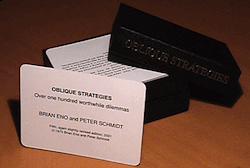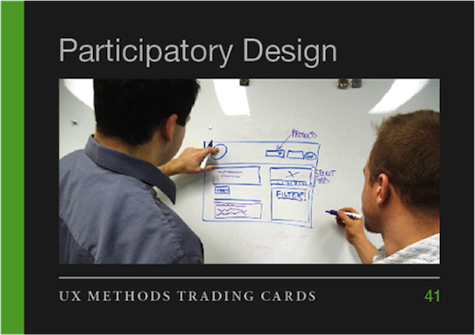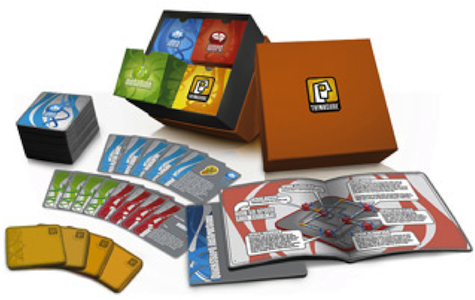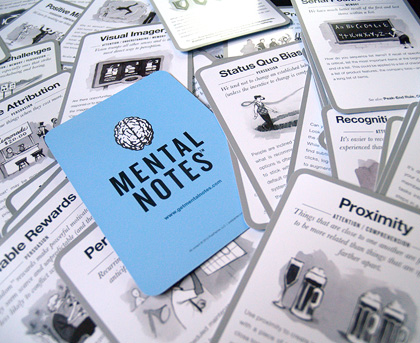It’s a new year. We’re back at work, busy with projects and creating deliverables. Many of us have made resolutions to find more inspiration or to think more creatively this year.
Like many practitioners, my day-to-day to work involves facing situations in which I am unsure of what to do next. Clients and teams look to me for solutions, ideas, and methods that can help create great ideas and experiences. Every now and then I, like anyone else, struggle to remain fresh and creative. When I catch myself falling into a rut or back to approaches that I’m comfortable with, I try to challenge myself to do something different. As a good friend of mine says, “If you’re stuck, try to figure out how to get unstuck.” Often I return to my library of UX books and tools, but in particular, I like to return to my collection of UX card sets.
By “UX card sets” I mean a collection of ideas, concepts, or approaches assembled into a card deck. My collection of card sets includes ones that are, for me, relevant to UX work. Like playing cards, cards are generally printed on heavy paper, board, or plastic, and are usually palm size, which makes them easy tp handle and share.
Why cards? They’re more tactile and make it easy to quickly access possible approaches to problem solving. And in most cases cards are portable, which comes in handy when running workshops with clients or peers, as you can always have them with you. As well, the small size of the cards means they have to explain concepts compactly making it easier to quickly explain and understand.
There are many creativity tools that come in the form of a deck of cards. Below are some of my favorite sets that I suggest exploring.
Oblique Strategies
Brian Eno and Peter Schmidt
https://enoshop.co.uk/oblique.asp
Originally released in 1975, this deck contains over one hundred “worthwhile dilemmas.” Each card presents a question, dilemma, or new way of thinking about the work you are doing. The cards provide a number of options for thinking of problems from different angles.

Brian Eno says:
The cards evolved from me being in a number of working situations when the panic of the situation—particularly in studios—tended to make me quickly forget that there were others ways of working and that there were tangential ways of attacking problems that were in many senses more interesting than the direct head-on approach. If you’re in a panic, you tend to take the head-on approach because it seems to be the one that’s going to yield the best results. Of course, that often isn’t the case—it’s just the most obvious and, apparently, reliable method. The function of the Oblique Strategies was, initially, to serve as a series of prompts which said, “Don’t forget that you could adopt this attitude,” or “Don’t forget you could adopt that attitude.”
According to the website “They can be used as a pack (a set of possibilities being continuously reviewed in the mind) or by drawing a single card from the shuffled pack when a dilemma occurs in a working situation. In this case, the card is trusted even if its appropriateness is quite unclear. They are not final, as new ideas will present themselves, and others will become self-evident.”
One thing to note is that the decks aren’t cheap (used copies of the earlier editions can cost thousands of dollars online), but well worth it. The decks have changed through the four editions with some cards being dropped, modified and added along the way. You can buy the 5th edition for £30 from the EnoShop, but not all the cards from the previous four editions are in it.
Here’s a great text listing of the cards from the various editions if you don’t want to purchase a deck:
Other options:
- @Oblique_Chirps on Twitter
- A web version from Gregory Taylor
- An iPhone version called Methodology inspired by Oblique Strategies
UX Trading Cards
nForm User Experience
https://nform.ca/tradingcards/
I’m a little bit biased towards nForm’s cards as I used to work at nForm. But I have to admit that before I joined the team, when I was struggling for ways to approach a workshop with a client or for ideas on how I could solve a problem, their UX Trading Cards were often a point of reference. They also continued to be a helpful tool too when I worked there.
The sets first came out in 2007 at the IA Summit. Jess McMullin (formerly at nForm, now at the Centre for Citizen Experience) created a deck of 16 cards that show methods, deliverables, and ideas that practitioners can use to design great user experiences.
I like using these cards in a couple different ways. Just pulling a random card and talking about the method can spur ideas when a team is having a hard time determining an approach. Grouping or combining cards, as with the Oblique Strategies cards, is also a good way to map out a set of project steps and approaches. Another use is in explaining what you’re planning to do with clients or stakeholders. Rather than just saying you’re going to create a concept model, you can hand them a card showing what a concept model is and why it is used. I’ve also just given a client a deck of cards and had him pick a method that might work for his organization.
The last set of cards was published in 2009 (for UX London). But I suspect we’ll see more from the good folks at nForm.
Method Cards
IDEO
https://.ideo.com/work/method-cards
IDEO Method Cards were first released in 2003 as a printed deck intended to be inspiration for practicing and aspiring designers, as well as for those seeking a creative spark in their work. IDEO conceived of the cards as a design research tool to help teams evaluate and select the best research methods for specific design initiatives.
The four groups of cards are organized as Ask, Watch, Learn, and Try, and they define the activities used for each method and provide a real-life example of how the method has been applied to a project. As the new methods develop, IDEO expects the card deck will grow.
The Method Cards are great for solving particular problems such as the “how do we get there from here” type of problems. They can help you explore new approaches to problem solving, gain perspective, inspire a team, turn a corner, try new approaches, and adapt and develop your own methods.
In 2010 IDEO released an iPhone app of the Method Cards that is also worth checking out. It contains 8 cards to start, with the remaining deck available for purchase in-app. It’s helpful for when you don’t have a deck with you.
MetaMemes
Kes Sampanthar
https://.metamemes.com/
Part deck, but more game, MetaMemes is a collection of 200 ideas, techniques, and words that can be incorporated into brainstorming sessions or to help spur innovative thinking.
To play, you write down your goal, randomly draw six cards, and then combine two or more of the cards to brainstorm a new idea. A sample deck of cards is available online.
The simple combination of two seemingly different items forces you to think differently. The game play is quick and the combinations limitless.
Mental Notes
Stephen P. Anderson
https://getmentalnotes.com/
This deck brings together insights from psychology and human behavior into an easy reference and brainstorming tool. Each card, illustrated by the talented Kevin Cornell, defines the concept, explains how it applies to human behavior, and suggests ways of applying this concept to the design of websites and applications. The cards pull from social psychology, behavioral economics, cognitive neuroscience, gaming, rhetoric, persuasion, and seduction techniques. They’re designed to be used at almost any stage of product development, and are great for generating new ideas or finding creative solutions to problems, and they work well when used individually or in groups.
What really appealed to me about this deck is that Stephen works frequently in the UX space and the deck was considerate of some of the unique challenges we face.
Here’s an example from Kevin Cornell’s post about the deck:
Okay, you know that fancy chocolate company that wants you to design their site? And you’re looking for a concept? Well… let’s ask Fate to pick a card…[you pull the Achievements card]. So, people get more involved when they’ve got some sort of achievement to show for it. Hmm. Well, what if you had a section where people can show what chocolates they’ve tried? Like each chocolate is a medal they’ve earned. Or maybe the chocolates themselves just get ranked by how many people have tried them. Like a popularity meter. That’s a pretty good hook, right?
Stephen did a great UIE webinar in the fall of 2010 called Seductive Interaction Design that’s worth checking out for additional context on the cards and how they can be used. He also has a book titled Seductive Interaction Design: Creating Playful, Fun, and Effective User Experiences coming out soon.
I hope you found this article helpful. I’d love to hear about your UX cards or other tools you use to spur your creativity. Feel free to leave a comment.








